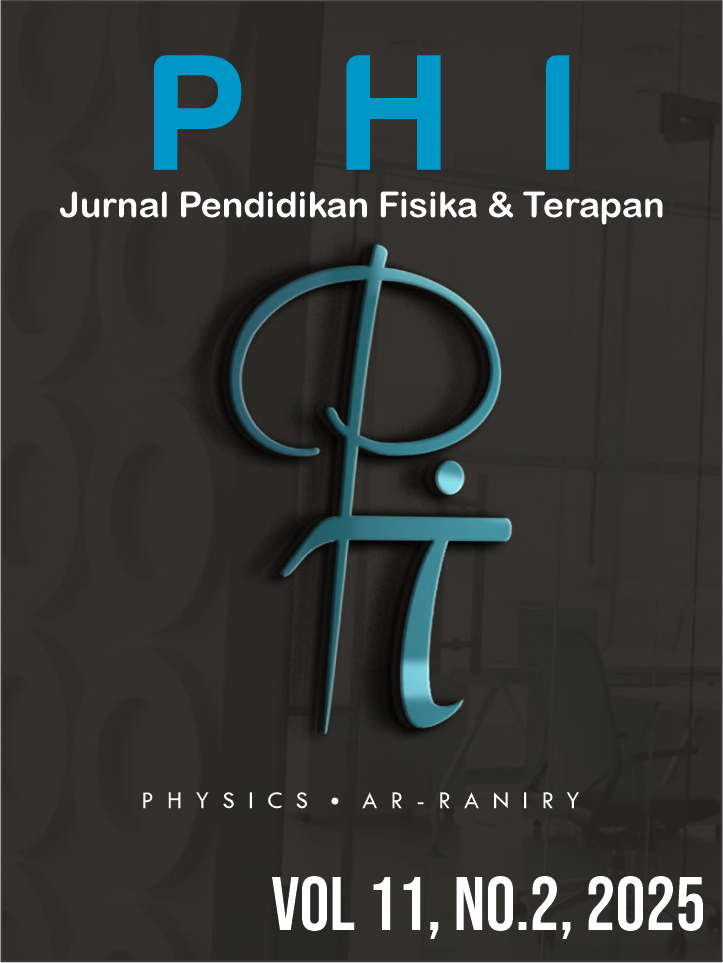Physico-Chemical and Magnetic Characterization of Topsoil Influenced by Vehicular Emissions at Padjadjaran University, Jatinangor
DOI:
https://doi.org/10.22373/yhp5n953Keywords:
Vehicle emissions, Magnetic susceptibility, Heavy metals, Soil pollution,Abstract
This study investigates the impact of vehicular emissions on the physico-chemical properties of topsoil at Padjadjaran University, Jatinangor. Soil samples were analyzed for pH, electrical conductivity (EC), total dissolved solids (TDS), magnetic susceptibility ()LFll, magnetic domain properties (), and heavy metal concentrations using Inductively Coupled Plasma-Optical Emission Spectrometry (ICP-OES). The results showed that while pH values remained within the neutral range (6.03–7.40), elevated EC and TDS values were observed at locations with high traffic density, indicating increased ionic content from anthropogenic sources. Magnetic susceptibility values ranged from 506.7 to 1148.7 × 10⁻⁸ m³kg⁻¹, with all sites exceeding 10 × 10⁻⁸ m³kg⁻¹, confirming the presence of ferrimagnetic minerals, and higher values were found near areas with heavy vehicle activity. The ) values, mostly below 4%, suggest a significant contribution from anthropogenic magnetic particles, dominated by stable single domain (SSD) and multi domain (MD) grains. Heavy metal analysis revealed that most elements (Fe, Mn, Cu, Zn, Al, As, Mg, Ca, K, Ni and Cr) were within permissible limits, except cadmium (Cd), which exceeded background crustal levels, suggesting contamination from anthropogenic sources, including vehicle emissions.
References
Alloway, B. J. (1995). Heavy Metals in Soils. Blackie Academic & Professional. London, United Kingdom.
Azizah, D. N., Fitriani, D., Agustine, E., Kirana, K. H., & Mulyana, A. A. (2024). Identifikasi Pencemaran Tanah Pada Kawasan Industri Baja Melalui Sifat Magnetik Dan Morfologi Bulir Magnetik. Bulletin of Scientific Contribution: GEOLOGY, 22(1), 71–80. https://doi.org/10.24198/bsc.v22i1.54102
Arlindia, I., & Afdal, A. (2015). Analysis of Lake Maninjau Pollution from TDS Values and Electrical Conductivity. Jurnal Fisika Unand, 4(4), 325–331. https://doi.org/10.25077/jfu.4.4.%25p.2015
Brady, N. C., & Weil, R. R. (1996). The nature and properties of soils.
Bijaksana, S., & Huliselan, E. K. (2010). Magnetic properties and heavy metal content of sanitary leachate sludge in two landfill sites near Bandung, Indonesia. Environmental Earth Sciences, 60(2), 409–419. https://doi.org/10.1007/s12665-009-0184-4
Choo –in, S. (2019). The Relationship Between The Total Dissolved Solids And The Conductivity Value Of Drinking Water, Surface Water And Wastewater. Suan Sunandha Rajabhat University, Bangkok, Thailand. ICBTS.
Dearing, J. A. (1999). Environmental Magnetic Susceptibility Using the Bartington MS2 System. British Library Cataloguing in Publication Data.
Handayani, C. O., Sukarjo, S., & Dewi, T. (2022). Penilaian Tingkat Cemaran Logam Berat Pada Lahan Pertanian di Hulu Sungai Citarum, Jawa Barat. Jurnal Ilmu Lingkungan, 20(3), 508–516. https://doi.org/10.14710/jil.20.3.508-516
Hanifah, S. D., Hendrayani, R., Carrisa, R., Rizki, M. I., Rohman, M. A., Hutabalian, M. A., ... & Fitriani, D. (2024). Mapping of pH, EC, and TDS Parameters to Identify Water Quality in Situ Cisanti. Phi: Jurnal Pendidikan Fisika dan Terapan, 10(1), 91-97. http://dx.doi.org/10.22373/p-jpft.v10i1.22175
Jordán, M. M., Rincón-Mora, B., & Almendro-Candel, M. B. (2016). Heavy metal distribution and electrical conductivity measurements in biosolid pellets. Journal of Soils and Sediments, 16, 1176-1182.
Li, X., Poon, C. S., & Liu, P. S. (2001). Heavy metal contamination of urban soils and street dusts in Hong Kong. Applied geochemistry, 16(11-12), 1361-1368. https://doi.org/10.1016/S0883-2927(01)00045-2
Lu, S. G., & Bai, S. Q. (2008). Magnetic characterization and magnetic mineralogy of the Hangzhou urban soils and its environmental implications. Chinese journal of geophysics, 51(3), 549-557. https://doi.org/10.1002/cjg2.1245
Lu, S., Wang, H., & Guo, J. (2010). Magnetic response of heavy metals pollution in urban soils : magnetic proxy parameters as an indicator of heavy metals pollution. World Congress of Soil Science, Soil Solutions for a Changing World, August, 32–35.
Maharani, I.S., & Budiman, A. (2018). Analisis Suseptibilitas Magnetik dan Kandungan Logam Berat pada Tanah Lapisan Atas di Sekitar Pabrik PT Semen Padang. Jurnal Fisika Unand, 7(2), 172–178. https://doi.org/10.25077/jfu.7.2.172-178.2018
Palar, H. (1994). Pencemaran dan toksikologi logam berat. Jakarta: Rineka Cipta, 148.
Solomon, J. S., Ahmed, A. L., Adamu, I. H., & Dimu, O. O. (2017). Identifying anthropogenic metallic pollutants using frequency dependent magnetic susceptibility. Current Trends in Natural Science, 6(11), 13–22.
Telford, W. M., Geldart, L. P., & Sheriff, R. E. (1990). Applied geophysics. Cambridge university press.
Turekian, K. K., & Wedepohl, K. H. (1961). Distribution of the elements in some major units of the earth's crust. Geological society of America bulletin, 72(2), 175-192.
World Health Organization (WHO). (1996). Permissible limits of heavy metals in soil and plants. Geneva, Switzerland.
Yulius, U., & Afdal, A. (2014). Identifikasi sebaran logam berat pada tanah lapisan atas dan hubungannya dengan suseptibilitas magnetik di beberapa ruas jalan di sekitar Pelabuhan Teluk Bayur Padang. Jurnal Fisika Unand, 3(4), 198-204.
Downloads
Published
Issue
Section
License
Copyright (c) 2025 Fadia Tri Septiani, Dini Fitriani, Eleonora Agustine, Kartika Hajar Kirana, Bayu Gusti Pangestu Aji

This work is licensed under a Creative Commons Attribution-NonCommercial 4.0 International License.
Authors who publish with Jurnal Phi agree to the following terms:
- Authors retain copyright and grant the journal right of first publication with the work simultaneously licensed under a Creative Commons Attribution License (CC BY 4.0) that allows others to share the work with an acknowledgment of the work's authorship and initial publication in this journal.
- Authors are able to enter into separate, additional contractual arrangements for the non-exclusive distribution of the journal's published version of the work (e.g., post it to an institutional repository or publish it in a book), with an acknowledgment of its initial publication in this journal.
- Authors are permitted and encouraged to post their work online (e.g., in institutional repositories or on their website) prior to and during the submission process, as it can lead to productive exchanges, as well as earlier and greater citation of published work (See The Effect of Open Access).

















